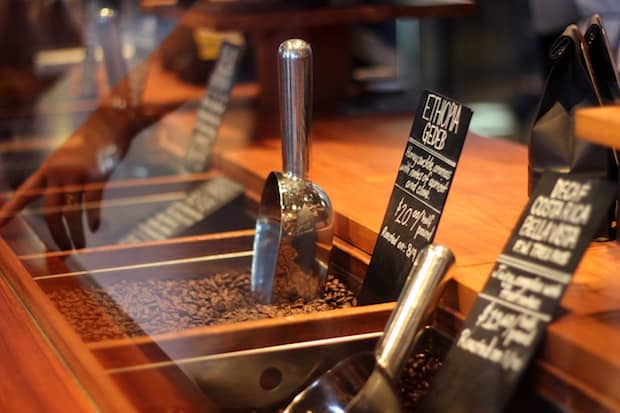Last Updated on December 13, 2023
Picture this: It is Saturday morning, and you have decided to visit the new coffee shop that opened recently near you that serves specialty coffee. You walk in and immediately the aroma of freshly roasted coffee beans envelops you. The shop is small but cozy, and there are are a few customers seated around the café on plush cushions, working diligently on their laptops, or perhaps enjoying a conversation with their friends.
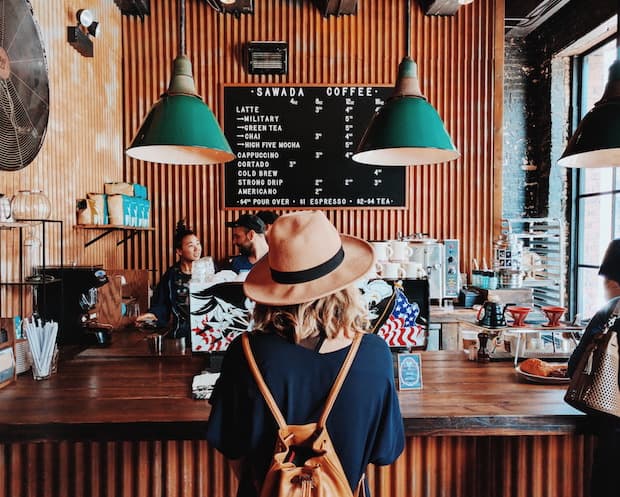
You spot the vibrant, colorful Coffee Taster’s Flavor Wheel on the wall, among other creative pieces of artwork that decorate the walls. A friendly barista greets you and you glance at the tastefully decorated chalkboard menu that lists today’s coffees. They are offering two single-origin coffees and one coffee blend. The menu descriptions of each coffee detail the roast level, origin, and tasting notes. You also note that there are several different brewing methods to choose from.
This modern coffee shop is a perfect example of the third-wave experience of coffee, and specialty coffee is necessary for a third-wave experience.
But what exactly does do specialty coffee and third-wave mean?
If coffee is described as gourmet or premium, this does not necessarily mean that it is specialty coffee—this may just be marketing. The technical definition of specialty coffee, as described by the Specialty Coffee Association (SCA), is Arabica coffee with a total quality (Q) score of at least 80 out of 100. To help you better understand this definition, however, I will provide a little more background.
Arabica vs. Robusta
There are two main species of coffee: Coffea arabica (Arabica) and Coffea canephora (Robusta).
Arabica coffee shrubs are more delicate and more susceptible to inclement weather and disease. Compared to Robusta coffee shrubs, Arabica shrubs have fewer branches and cherries competing for nutrients, so individual cherries are able to absorb more nutrients, creating richer, more complex flavor profiles.
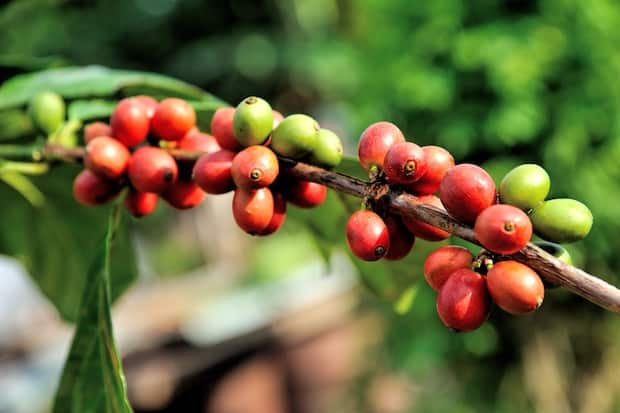
Robusta shrubs, aptly named, are more robust and less susceptible to adverse conditions. The shrubs are denser, so the cherries don’t receive as many nutrients, and they also produce more bitter-tasting compounds than Arabica plants to ward off pests. Both of these qualities lead to more bitter, less complex flavor profiles.
Arabica comprises about 60 per cent of coffee grown globally.
How coffee is graded
Coffee is graded by receiving quality (Q) scores out of 100 from certified Q graders— people who are certified by the Coffee Quality Institute to evaluate coffees based on the Specialty Coffee Association (SCA) best practices. The Q grading program is a six-day SCA training course that gives cuppers the opportunity to try coffees of many different origins and learn how to evaluate them using the same vocabulary and attributes to describe coffee. The Q grading program was launched in 2004 by the SCA to standardize the definition of specialty coffee.
As I mentioned, an Arabica coffee that receives a Q score of at least 80 is considered specialty coffee. The coffee must also have minimal defects to be considered specialty coffee; that is, the green coffee beans must have no primary defects and no more than five secondary defects, as defined in the SCA Grading Green Coffee protocol.
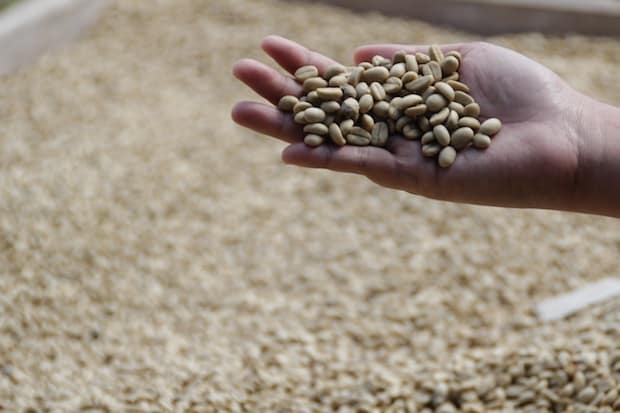
The total Q score is the sum of the scores of 10 individual components: fragrance/aroma, flavor, aftertaste, acidity, body, uniformity, balance, clean cup, wweetness, and overall. Each of these components is scored out of 10, and then added together for a total Q score out of 100. If there are defects, points are subtracted from the total score. A Q score of at least 60 is considered commercial grade coffee, and a Q score of at least 80 is considered specialty coffee. The coffee flavor, and therefore the Q score, can be affected by many factors prior to roasting and brewing, such as climate and weather, other agricultural conditions, production practices, type of processing, etc.
What is the difference between specialty coffee and third-wave coffee?
The major difference between specialty coffee and third wave is that specialty coffee is a product, while third wave is an experience. You cannot have a third-wave experience without specialty coffee, but you can have specialty coffee without the third-wave experience.
The first wave of coffee was comprised of primarily pre-ground, super dark roast, very bitter, often stale ground coffee found in the coffee aisle of the supermarket. Brands such as Folgers, Maxwell House, and Green Mountain coffee emerged in the first wave—brands without a strong focus on quality or origin.
The second wave of coffee was marked by the rise of companies like Starbucks, introducing coffee consumers to a wider variety of coffee experiences, such as creative flavored lattes and frappes. Although there was slightly more recognition of the coffee origin than in the first wave, the emphasis of the second wave is more on these creative drink experiences and the atmosphere of the coffee shop, than on the quality of the coffee beans themselves. Coffee was still roasted very dark to deliver a consistent, uniform experience.
In the 1980s, a small group of roasters and cafes experimented with lighter roast levels and bringing out new and interesting flavors in high-quality coffee. Thus, the Specialty Coffee Association was born in 1982. The phrase “third wave of coffee” was coined in 1999 and quickly caught on.
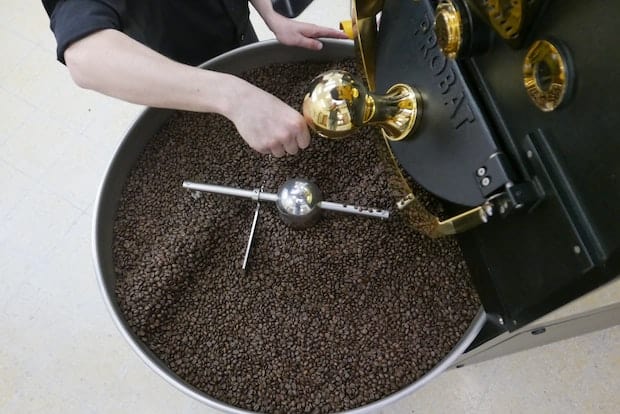
The third wave of coffee places a strong emphasis on coffee quality. Specialty grade coffee is required for a third-wave experience. With this movement came reimagined roasting and brewing methods, transparency of origin, transparency of roasting dates, and connecting consumers to the story behind the cup. Quality-forward companies like Blue Bottle and Intelligentsia emerged within a growing specialty coffee industry.
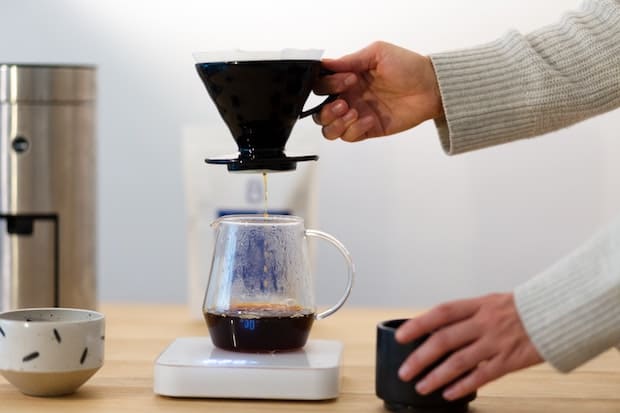
Consumers were beginning to realize that a cup of coffee did not have to taste bitter and burnt; rather, coffee could have sweeter and more complex flavor profiles. Coffee roasters and retailers began to list specific flavor notes. There are not undesirable flavors to mask with over-roasted beans as there were in the first and second waves; rather, the goal is to enhance the distinctive, desirable flavors of the beans by using lighter roasts and diverse brew methods such as French press and pour over. The third wave is centered around coffee quality and consumer involvement.
How to find and brew specialty coffee
Specialty coffee is not typically in the coffee aisle of your average supermarket. You can buy specialty coffees from cafes and coffee shops, directly from a roaster, or online.
Regardless of where you buy your coffee, be sure to look at the “roasted on” date if there is one. This is more important than the “best by” or “freshest by” date to ensure freshness and quality. If has been more than two or three weeks since the coffee was roasted, it has likely lost some flavor quality. When brewing, remember to use good quality, filtered water, as unfiltered or mineral-rich water will affect the flavor, and to follow these tips to minimize bitterness.
Now that you’ve learned about specialty coffee, next time you go to your local coffee shop or roaster, I challenge you to pay attention to the origin, roast level, and flavor. Is it better than the instant coffee you’ve tasted? What differences do you taste?
References
“Protocols and Best Practices,” Specialty Coffee Association: https://sca.coffee/research/protocols-best-practices
“Coffee Professionals Discuss: What is Specialty Coffee?”, Perfect Daily Grind: https://perfectdailygrind.com/2017/07/coffee-professionals-discuss-what-is-specialty-coffee/
“The Ultimate Guide to Buying Specialty Coffee Beans,” JavaPresse: https://www.javapresse.com/blogs/buying-coffee/ultimate-guide-buying-specialty-coffee-beans

